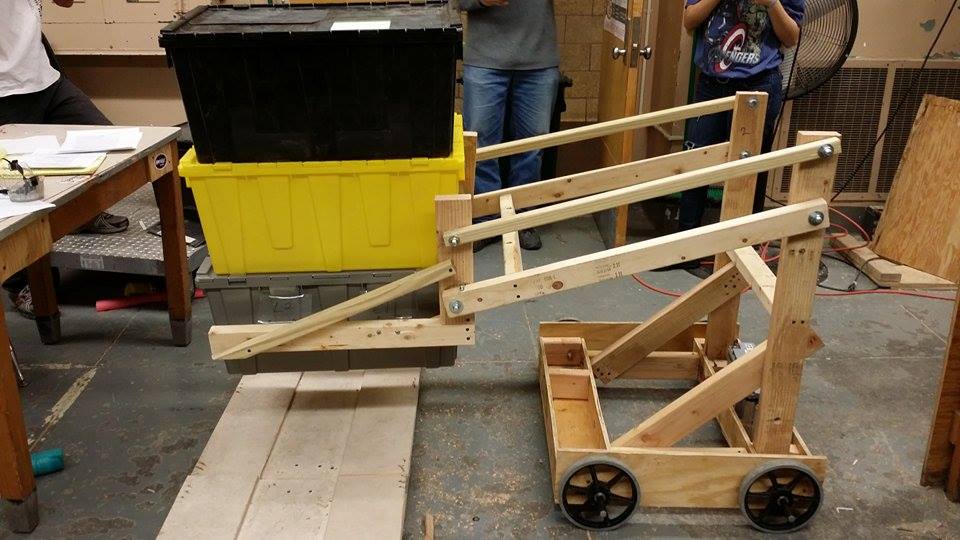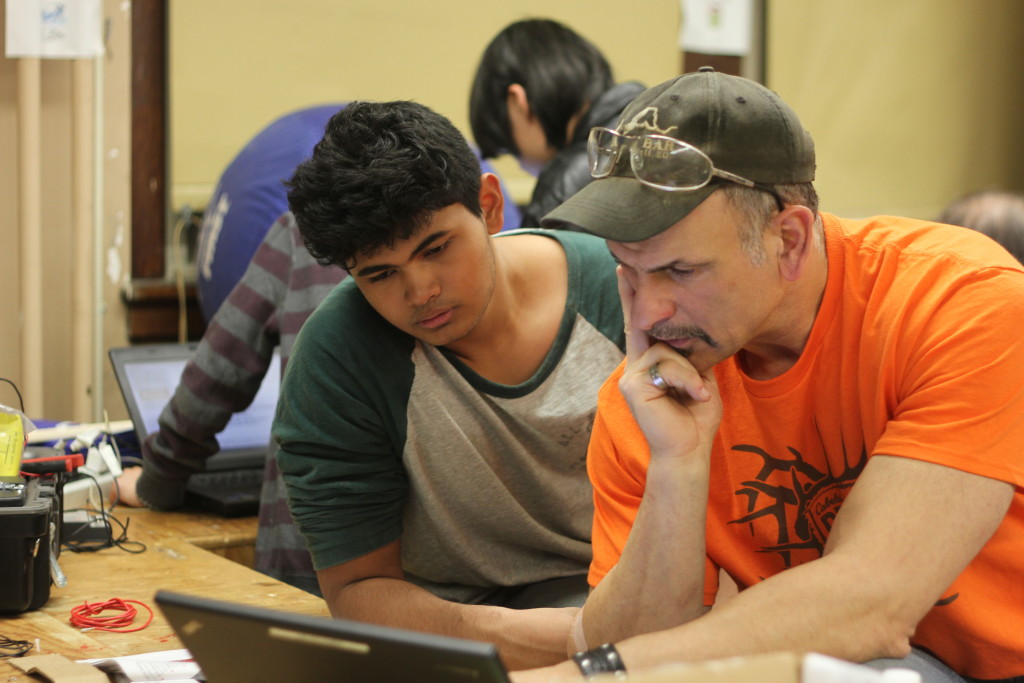Team 1635 not only builds robots for international high school competitions but also to help develop an interest for engineering in young children. On April 28 a few of the members from the team volunteered to lead an activity at AllianceBernstein for its Take Your Child to Work Day event. Here the team members taught basics of mechanical engineering, electrical engineering and programming. We worked on a basic assembly of a car module, amping it up with the usage of ultrasonic sensors. This allowed for the car to turn when it detected the distance between it and a barrier via soundwaves. It was a great turn out and it became evident that the children were intrigued as they asked multiple questions all pertaining to engineering. We hope to do this again next year in order to further promote robotics.
Category: Blog
All the updates of the team will be here.
Going Over Defenses – Team 1635
This is a montage that showcases how Team 1635’s award-winning 2012 robot can cross the defenses of the FRC 2016 game.
Video Edited by: Li Jing Wei
Prebuild Season | Team 1635
The new members of Team 1635 getting to know each other and a little fun before the actual build season begins.
Video edited by: Li Wei Jing
Music – Walk The Moon – Different Colors
FOX News Visits the Team
FOX News came to Newtown High School recently to conduct a new segment called ‘The Big Idea: Junior’. Our lead coach, Ms. Gonzalez very kindly prepared a series of questions in order to ensure we didn’t look completely dumbfounded at the startle of a camera. The morning that FOX came to our workshop the majority of us were pulled from class and given a few words by Mr. Paolino and Ms. Gonzalez. When the camera crew arrived we were told to act as we would any other day. Everyone was doing their assigned task whether it was working on tabs or working on the program. We used the practice robot we had instead of the actual robot we had built since we weren’t really supposed to take the official robot out of the bag. Dan Bowens interviewed around five members of the team: our Captain, Chrys, our head programmer, Li alongside Sade, our head designer Manish and myself. We were asked questions similar to those Ms. Gonzalez had anticipated. We were asked about our role in the team, the function of the competition and the function of the team in general. We were very excited and enjoyed having this experience.
Week 6: Practice
This week was a combination of practicing and perfecting. Our driving team Chrys Sanchez and Manish Shretha maneuvered the controls to best complete the objective we needed. We practiced getting totes to and fro from their designated areas. We saw the various ways in which we could stack the boxes and in how many sets of them at a time. The team looked for the easiest and fastest way to get more done in a smaller period of time. Apart from this we also did a lot of troubleshooting, in the sense that we looked how to solve any problems that my come our way during competition. We checked how we would lift the can if it were on its side or even upside down. Overall, this was a week of problem-solving.
Week 5: Testing & Practicing
This week was particularly heavy for our programming department. This was the week in which we would test all of the functions and make sure that everything was working the way that it should. Our head programmer Li, alongside our mentor Bob led most of the testing on the robot. They ensured that the actuators were working at the same speed so that there would be no problem when trying to pick up totes and put them down. We didn’t want one actuator moving faster than the other, that would be unfortunate. Also during this week, we tested out our Autonomous. We had some difficulty in this department being that we got off to a rough start. However, by the end of the week, our programming team figured out the issue and made it run smoothly. Also towards the end of the week we got to do some practicing with a different school, Brooklyn Tech, they were kind enough to lend us some practice space. This week was quite a long one but in the end its where we made the most improvements on Midas.
Week 4: Building Midas
Now that we had the prototype tested and knew that the model we built was going to work we started to make it out of metal. Like when building the prototype we gathered all the materials that we knew were necessary. Building the prototype made building Midas easier to construct because we already knew how the pieces were exactly supposed to fit. Again, we separated into groups so that we all did our designated jobs. Those who worked in electrical fixed up the wires and made things neater on the board so that the aesthetics of the board would be presentable. The mechanical team built the frame and claw into the robot. The programming team made some tweaks on how it is they thought the robot would drive best. By the end of the week we had assembled the robot and had some early practice.
Week 3: Testing the Prototype
Week three of building we spent testing our prototype robot. The tests were run by the programming department. They tested out the function of the prototype and decided on what adjustments it was that they wanted to make on the robot. After we saw what it was that we needed to fix we repaired all minor mistakes. We realized that there were two pieces that were the wrong distance away from each other and made th correction. Overall, I like to think that the mistakes were not that major. The test ran smoothly the majority of the time. Li and Sade worked alongside our mentor Bob to make sure that everything was running the way that it was supposed to. It was a calm week filled with trouble shooting and problem solving.
Week 2: The Prototype
In this week the team focused on building a prototype. Looking at the design that Manish perfected, we began the first draft of our robot. We gathered all the pieces of plywood, rivets, screws and such that we were going to need. After we saw that everything was in check we started putting pieces together. We cut wood for almost an entire day just to get the correct measurements that were displayed in the design. Another day we riveted and screwed the pieces in place. Being that we wanted to get as much done in a faster amount of time we divided in groups. One group would be working on the claw where others in the wheels, others on the frame and others on the electrical. This way we made sure that everything was being taken care of in an efficient manner. After each group did their task the only thing left to do was to to put all the pieces together. It was very fun to see what was to come when building the actual robot. We learned a great deal and hope to keep making improvements on its structure so that it can better function.
Week 1: Concepts & Design
This week was largely based on conceptualizing everything in relation to how it is we wanted the robot to work. We thought of the best ways in which we could assemble this robot. After reading the manual entirely we had the fundamentals on what the objective was and all the regulations we had to consider. The team would gather and discuss the best way we could pick up the boxes and tote. We thought of different methods: elevators, claws and such. We deduced the best way of getting what needed to be done and decided on the final design. This week was a busy one, specifically for our design team. Head of the design team, Manish Shrsetha alongside the rest of the team worked to get the team’s vision across by using Autodesk Inventor. By the end of the week we had a solid plan for what it was that our robot was supposed to look like and function.



